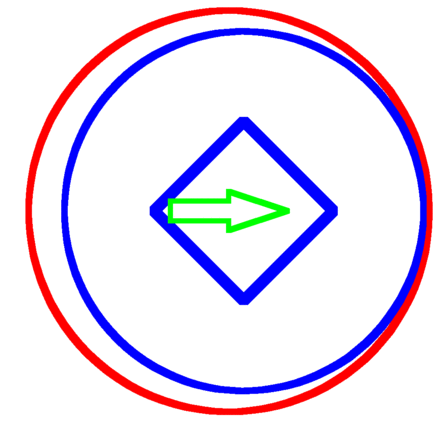 | ||
Precession, also called epicyclic fretting precession, (or more accurately hypocyclic fretting precession since "epicyclic" applies to a round part spinning outside a circle and "hypocyclic" applies to a round part spinning inside a circle) is the process of a round part in a round hole rotating with respect to that hole because of clearance between them and a radial force on the part that changes direction. The direction of rotation of the inner part is opposite to the direction of rotation of the radial force. Fretting between the part and the hole is often a result of this motion. "In machinery, fretting is the micro-motion of tightly fitting parts that superficially appear immobile with respect to each other."
Contents
- Examples
- Automobile lug nuts
- Bicycle pedals
- Bicycle bottom brackets
- Bearings in manual transmissions
- References
"For a pedal, a rotating load arises from downward pedaling force on a spindle rotating with its crank making the predominantly downward force effectively rotate about the pedal spindle. What may be less evident is that even tightly fitting parts have relative clearance due to their elasticity, metals not being rigid materials as is evident from steel springs. Under load, micro deformations, enough to cause motion, occur in such joints. This can be seen from wear marks where pedal spindles seat on crank faces."
This precession is a process purely due to contact forces and does not depend on inertia and is not inversely proportional to spin rate. It is completely unrelated to torque-free and torque-induced precession.
Examples
Precession caused by fretting can cause fastenings under large torque loads to unscrew themselves.
Automobile lug nuts
Automobiles have also used left-threaded lug nuts on left-side wheels, but now commonly use tapered lug nuts, which do not precess.
Bicycle pedals
Bicycle pedals are left-threaded on the left-hand crank so that precession tightens the pedal rather than loosening it. This may seem counter-intuitive, but the torque exerted due to the precession is several orders of magnitude greater than that caused by a jammed pedal bearing.
Bicycle bottom brackets
English threaded bicycle bottom brackets are left-threaded on the right-hand (usually drive) side into the bottom bracket shell. This is the opposite of pedals into cranks because the sense of the relative motion between the parts is opposite. (Italian and French threaded bottom brackets have right-hand threading on both sides.)
Bearings in manual transmissions
A bearing supported gear in a manual transmission rotates synchronously with its shaft due to the dog-gear engagement. In this case, the small diametrical clearance in the bearing will induce precession of the roller group relative to the gear mitigating any fretting that occurs if the same bearing rollers always push against the same spot on the gear. Typically the 4th and 5th gears will have precession inducing features, while 1st through 3rd gears might not since cars spend less time in those gears. Transmission failure due to lack of precession is possible in gear boxes when low gears are engaged for long periods of time.
